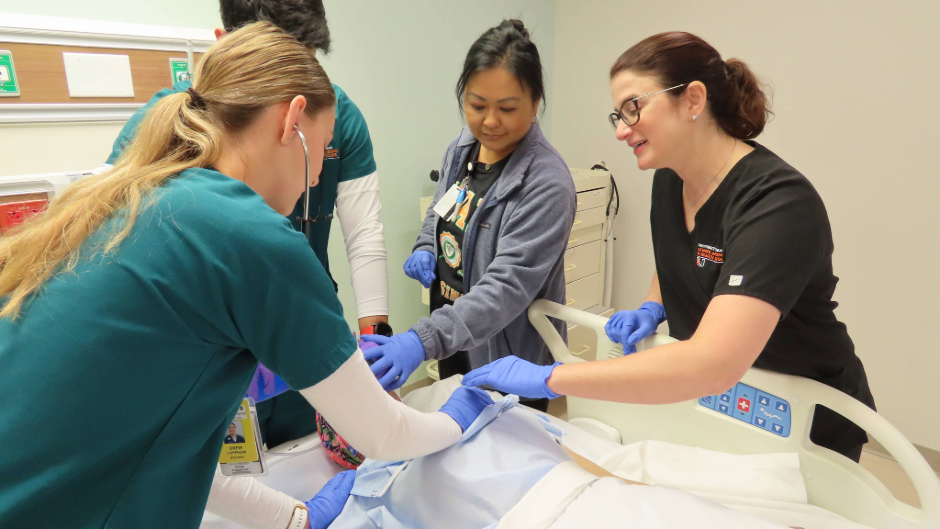So strong is the team spirit between Jacqueline “Jackie” Lopez, BSN, RN, CHSE, and Michelle Osso, MSN, RN, CGRN that they asked to be interviewed for this profile together. In fact, they say part of what makes their work as simulation educators at the Simulation Hospital Advancing Research and Education (S.H.A.R.E.®) so special is the way they and the rest of their colleagues collaborate daily on the complex activities required to successfully run a wide range of health care scenarios for students from the University of Miami School of Nursing and Health Studies.
It takes extensive effort, skill, and coordination to create learning experiences that come as close to real life as possible on several levels. When running simulations, one simulation educator is inside the control room with technicians, overseeing the logistics of the simulation, while another is in the scenario room with students, observing student interactions and ensuring that everything feels and looks accurate.
With S.H.A.R.E. simulation experts like these two coming from diverse specialties and backgrounds, students gain a rich, comprehensive education and benefit from the perspectives of successful nurses at the top of their fields. The chance to spark knowledge in future nurses is what inspires Jackie, Michelle, and the rest of the S.H.A.R.E. team, to keep teaching. “We are proud to know we are sending confident, intelligent, resourceful nurses into the community,” they say.
Whenever possible, they also share their work with the wider nursing community. Jackie and Michelle were among the authors of “Pandemic Crisis: Simulation Contingency Plans,” an account of the S.H.A.R.E. team’s quick actions to benefit students at the start of the COVID-19 pandemic, published in 2021 in Teaching and learning in nursing: Official journal of the National Organization for Associate Degree Nursing.
Q: How did you come to S.H.A.R.E.?
Jackie Lopez: I started as a per diem clinical instructor at SONHS in 2012, after working as an Emergency Department nurse in a local hospital. After seeing the impact simulation had on nursing students’ education here, I decided to fully transition my career into this field. I have been a full-time simulation educator here since April 2014—I started three years before the grand opening of our five-story, 41,000-square foot S.H.A.R.E. facility.
Michelle Osso: I started in orthopedic medical-surgical nursing at a Miami hospital before becoming a nurse educator in that hospital’s endoscopy department. Then one day, in my daughter’s dance class, I met another dance mother, Gloria Trujillo, who also was a nurse. She mentioned an opening for a simulation nurse educator at the University of Miami. I already had my master’s degree in nursing education, and I was very intrigued by the use of simulation at SONHS, so I applied. I was hired full-time in October 2016, and I’ve never looked back!
Can you talk about your experiences teaching with simulation in the curriculum versus without.
MO: I had never taught using high-fidelity simulations before I came here. Incorporating simulation in the curriculum contributes to improving patient safety and the confidence of nursing students as well. Once these students get to a clinical setting, they’ve already seen the environment and practiced the skills needed. They enter the hospital having more confidence in their knowledge.
JL: I would say students definitely learn better with simulation than without it. At S.H.A.R.E., we assure all students that this is a safe environment and that mistakes are part of learning. We also stay current with best practices and evidence-based recommendations from the Society for Simulation in Healthcare. They offer a Certified Healthcare Simulation Educator® (CHSE) credential, which I have.
Can you say more about patient safety and simulation education?
JL: We have a lot of students coming in right now for the start of the semester. They’re learning how to put on their gowns and their PPE (personal protective equipment), and take vital signs. Then in three weeks, they’ll go to the clinical settings. With the simulation, as they practice basic skills over and over, they gain a fundamental understanding of the work they’re doing. S.H.A.R.E. is the best place for them to safely close their knowledge gap.
Can you share an example of a time when you’ve seen simulation’s power to bridge that knowledge gap for students?
MO: Definitely. We had a group of students running a simulation on how to perform CPR and manage a code. The very next day, they came back from clinicals and said, “Thank goodness we reviewed that!” A patient had coded, and because they practiced protocol in simulation, they knew exactly what to do and ran into action. That was proof right there that simulation works.

